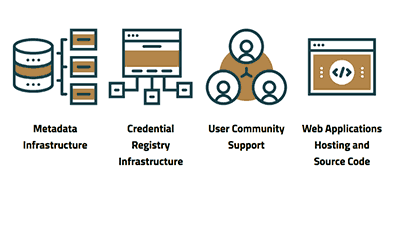What if we had a “GPS” for credentialing—an easy-to-use system that would help us navigate the maze of degrees, certificates, certifications, and other credentials in today’s workplace? Such a system would benefit everyone—including learners, employers, policymakers, career counselors, licensing and certification organizations and accrediting agencies—by providing accurate, current, and transparent information about the array of credentials awarded by multiple providers.
Such a system isn’t a pipedream. Lumina Foundation has been collaborating with many partners to develop this vision.
The vision starts with our Global Positioning System. Few of us obtain data directly from the satellites that circle the earth sending data to receivers. Rather, we obtain information indirectly, through software applications such as Google Maps, Waze, or MapQuest. These and other navigation apps select and shape the information in user-friendly ways, helping us map a route between cities or addresses, find our way through an airport or mall, or catch a train using real-time transit updates.
A similar vision is emerging for credentialing: a networked system of data about all credentials, with various apps created that draw on that data to tailor-make information on credentials for different types of users.
This vision has been on the drawing board for the past few years. A group of forward-thinking folks assembled by the Lumina-supported Credential Transparency Initiative (CTI) explored the vision and came up with a plan of action. CTI conferred with many groups to identify the strengths and weaknesses of the current credentialing system. The result was growing conviction that we need a transparent system of credentialing—a “credentialing GPS.” We heard guidance such as: “Tell us what credentials we have in the U.S., what knowledge and skills they stand for, and what their value is.” The CTI then built a prototype Credential Registry, working with credential providers to capture key descriptors of their credentials.
There are three components in the prototype:
- An easy-to-understand language (Credential Transparency Description Language) to drive the GPS. The CTDL enables all types of credential providers to describe their credentials using common descriptors.
- An open-source platform (Credential Registry) has been created and is being tested by nearly 100 credential providers that have published a few hundred credentials to the registry.
- Apps—which will deliver tailor-made information from the registry to diverse users—are being developed. The first such app (Workit) is being tested. It lets a user learn about credentials and compare their many features.
In September 2016, several hundred partners attended a public summit to check out the Credential Registry and Workit prototype. The big takeaway from the summit: the need for transparency in our credentialing marketplace is so great that we should −we must −take it to scale. That led to the formation of a nonprofit organization called Credential Engine, whose mission is to scale up and maintain the new credentialing GPS. Credential Engine will maintain the registry as an open-source platform that includes all credentials—degrees, certificates, industry certifications, badges, diplomas, apprenticeship credentials, licenses, microcredentials, and others.
With Credential Engine up and running, can we declare victory? Do we have a GPS for credentials? Unfortunately, no. What we have is the vision, a promising prototype that has taught us what we need to do next, and the know-how to move to scale.
If we were truly building a geo-spatial GPS, of course, we would next send “credential” satellites into orbit and deploy camera-equipped vehicles across the globe to collect credentialing information to feed into the Credential Registry. But, credentials aren’t lying around our streets and backyards where satellites and cameras can see them. Rather, they’re buried in websites, locked into PDFs and on Word documents—often undiscoverable in a Web 3.0 world.
In moving forward, what can we learn from other industries? A lot. Consider the transportation industry. Most airlines, hotels, and rental car companies make their information discoverable. They voluntarily use common terminology and protocols so their information is readable to computers that spider out and collect information. This, in turn, enables software developers to make travel information readily available through apps such as Expedia, Travelocity, and Orbitz.
Many other industry sectors function in a similar way because they recognize the benefits of using common terminology and technology to connect information to enable a consumer-oriented marketplace to evolve and thrive.
Is the education sector—the credentialing sector—ready to go next? Our answer is a cautiously optimistic “yes” for three reasons:
- The vision is solid; we need to bring transparency to the complex, confusing credentialing marketplace.
- Diverse stakeholders need tailor-made information; the system must be open-source to enable apps to be developed for different users.
- Proven technical know-how exists to deliver a Credential Registry and apps.
Even with such compelling reasons, we know it will be difficult for credential providers to make their information discoverable by the Credential Registry.
What happens if we fail to set this new system in place? Picture an air transportation system with no common way to describe services, schedules, prices, and connections—and no easy way to connect and present information about multiple airlines, hotels, and more. This is what we have now in the world of education credentials. No common language to describe what we do and integrate this information easily from multiple sources, making it difficult for anyone to navigate the education-workplace landscape. What does a degree, badge, certification or certificate mean from the various providers who award them? Can they be understood by other educational institutions and employers? Who maintains the dictionary that defines credentials? No one. And, we don’t have quality standards commonly applied to the full range of credentials in our highly-decentralized credentialing system, so learners in our institutions are unevenly prepared.
Credential Engine work teams have done much of the heavy lifting by creating a prototype GPS for credentialing. Now it’s time for credential providers—colleges, universities, certification bodies, licensing agencies, and others − to step up and really fuel the engine. Then, software developers will be able to build the apps to bring the GPS to life.
